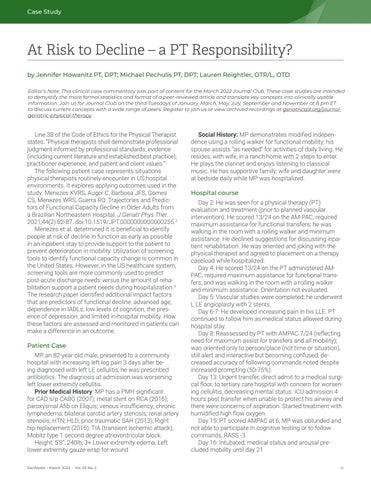Case Study
At Risk to Decline – a PT Responsibility? by Jennifer Howanitz PT, DPT; Michael Pechulis PT, DPT; Lauren Reightler, OTR/L, OTD Editor’s Note: This clinical case commentary was part of content for the March 2022 Journal Club. These case studies are intended to demystify the more formal statistics and format of a peer-reviewed article and translate key concepts into clinically usable information. Join us for Journal Club on the third Tuesdays of January, March, May, July, September and November at 8 pm ET to discuss current concepts with a wide range of peers. Register to join us or view archived recordings at geriatricspt.org/journalgeriatric-physical-therapy.
Line 3B of the Code of Ethics for the Physical Therapist states: “Physical therapists shall demonstrate professional judgment informed by professional standards, evidence (including current literature and established best practice), practitioner experience, and patient and client values.”1 The following patient case represents situations physical therapists routinely encounter in US hospital environments. It explores applying outcomes used in the study: Menezes KVRS, Auger C, Barbosa JFS, Gomes CS, Menezes WRS, Guerra RO. Trajectories and Predictors of Functional Capacity Decline in Older Adults from a Brazilian Northeastern Hospital. J Geriatr Phys Ther. 2021;44(2):82-87. doi:10.1519/JPT.0000000000000255.2 Menezes et al. determined it is beneficial to identify people at risk of decline in function as early as possible in an inpatient stay to provide support to the patient to prevent deterioration in mobility. Utilization of screening tools to identify functional capacity change is common in the United States. However, in the US healthcare system, screening tools are more commonly used to predict post-acute discharge needs versus the amount of rehabilitation support a patient needs during hospitalization.3 The research paper identified additional impact factors that are predictors of functional decline: advanced age, dependence in IADLs, low levels of cognition, the presence of depression, and limited in-hospital mobility. How these factors are assessed and monitored in patients can make a difference in an outcome. Patient Case MP, an 82-year-old male, presented to a community hospital with increasing left leg pain 3 days after being diagnosed with left LE cellulitis; he was prescribed antibiotics. The diagnosis at admission was worsening left lower extremity cellulitis. Prior Medical History: MP has a PMH significant for CAD s/p CABG (2007); metal stent on RCA (2016); paroxysmal Afib on Eliquis; venous insufficiency; chronic lymphedema; bilateral carotid artery stenosis; renal artery stenosis; HTN; HLD; prior traumatic SAH (2013); Right hip replacement (2016); TIA (transient ischemic attack); Mobitz type 1 second degree atrioventricular block. Height: 5’8”; 240lb; 3+ Lower extremity edema, Left lower extremity gauze wrap for wound GeriNotes • March 2022 • Vol. 29 No. 2
Social History: MP demonstrates modified independence using a rolling walker for functional mobility; his spouse assists “as needed” for activities of daily living. He resides, with wife, in a ranch home with 2 steps to enter. He plays the clarinet and enjoys listening to classical music. He has supportive family; wife and daughter were at bedside daily while MP was hospitalized. Hospital course Day 2: He was seen for a physical therapy (PT) evaluation and treatment (prior to planned vascular intervention). He scored 13/24 on the AM-PAC, required maximum assistance for functional transfers; he was walking in the room with a rolling walker and minimum assistance. He declined suggestions for discussing inpatient rehabilitation. He was oriented and joking with the physical therapist and agreed to placement on a therapy caseload while hospitalized. Day 4: He scored 13/24 on the PT administered AMPAC, required maximum assistance for functional transfers, and was walking in the room with a rolling walker and minimum assistance. Orientation not evaluated. Day 5: Vascular studies were completed; he underwent L LE angioplasty with 2 stents. Day 6-7: He developed increasing pain in his LLE. PT continued to follow him as medical status allowed during hospital stay. Day 8: Reassessed by PT with AMPAC 7/24 (reflecting need for maximum assist for transfers and all mobility); was oriented only to person/place (not time or situation), still alert and interactive but becoming confused, decreased accuracy of following commands noted despite increased prompting (50-75%). Day 13: Urgent transfer, direct admit to a medical surgical floor, to tertiary care hospital with concern for worsening cellulitis, decreasing mental status. ICU admission 4 hours post transfer when unable to protect his airway and there were concerns of aspiration. Started treatment with humidified high flow oxygen. Day 15: PT scored AMPAC at 6, MP was obtunded and not able to participate in cognitive testing or to follow commands, RASS -3. Day 16: Intubated; medical status and arousal precluded mobility until day 21 31




